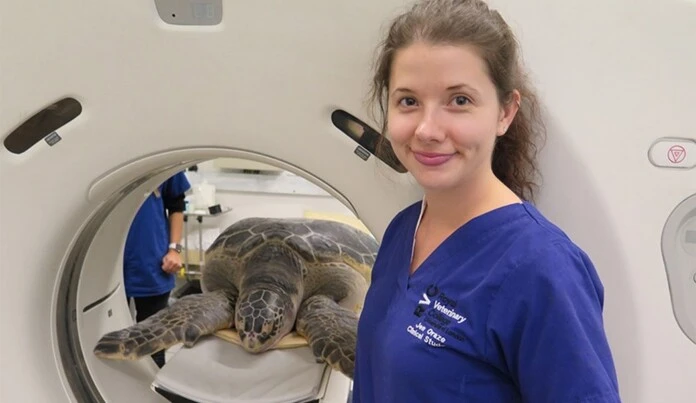When a massive loggerhead sea turtle was struck by a boat and brought to a veterinary hospital in Florida, the doctors were unsure how to proceed.
They needed to determine the extent of her injuries, but the CT scanner at the Loggerhead Marinelife Center in Juno Beach was too small for her large frame.
Nicknamed ‘Pennywise,’ the turtle was carefully loaded onto a truck and transported to the nearby Jupiter Medical Center, which had a CT scanner designed for humans. However, to their surprise, that machine was also too small for the elderly giant.
The team had to think creatively: what kind of animal is larger than a human and receives enough veterinary care to warrant an oversized CT scanner?
Their search led them to the Palm Beach Equine Clinic in Wellington. There, they asked—perhaps to the amusement of the equine veterinarians—if they could use the clinic’s horse-sized CT scanner.
“And luckily, the horse-sized machine was big enough to fit this lady through,” said Heather Barron, chief science officer and veterinarian at Loggerhead, in an interview with the Associated Press.
The extent of Pennywise’s injuries was not disclosed to the AP, but the CT scan did reveal a surprise: she was carrying a clutch of eggs.
“We hope to get her back out into the wild as soon as possible so she can lay those eggs,” Barron added.
Using CT scans for turtles injured by boat strikes is a relatively new veterinary practice. The Royal Veterinary College (RVC) in London helped pioneer the technique under the guidance of a Floridian student interested in using CT imaging for diagnoses.
In 2016, marine biology graduate Jen Oraze from the University of California, Santa Cruz, led a study at RVC that performed CT scans on five turtles with suspected spinal cord injuries.
Every year, dozens of sea turtles are rescued in the Florida Keys after collisions with boats. Some suffer chronic spinal injuries and lose the ability to dive without special weights.
Oraze became fascinated with CT scanning after learning that a consultant vet at a marine life center on England’s southern coast had run a Florida sea turtle named Ali through a CT machine. She went on to examine turtles at aquariums in England and Belgium, including one that was 70 years old.
Motivated by her findings, she hoped to make CT scanning a standard diagnostic tool for turtles in her home state of Florida as well.
